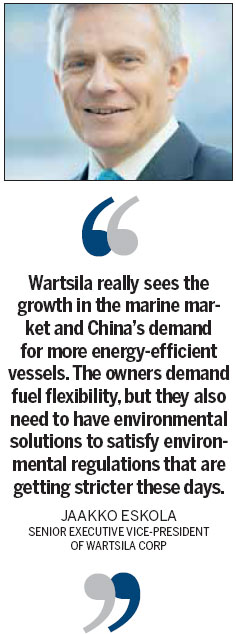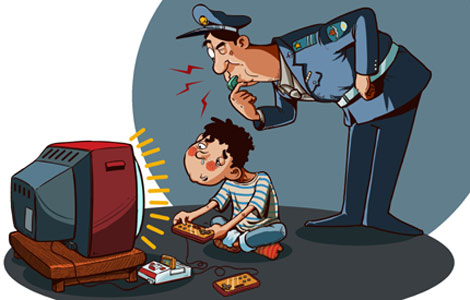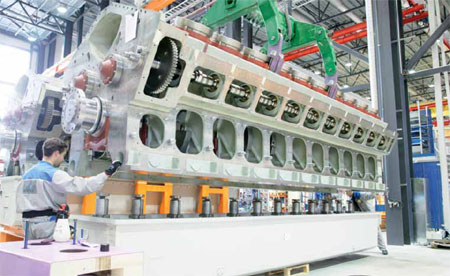Ship-engine maker powers on
Updated: 2014-01-31 06:42
By Zhong Nan (China Daily Europe)
|
|||||||||||
|
A Wartsila employee checks a ship engine. Wartsila is hoping to turn China into its biggest market. Provided to China Daily |
Chinese company's joint venture with Finnish partner to serve shipbuilders
Wartsila Corp, one of the world's largest ship power suppliers and manufacturers by revenue, is hoping to turn China into its biggest market by adding more manufacturing capacity in the country this year.
The Finnish company will open a joint venture, Wartsila Yuchai Engine Co Ltd, to make medium-speed marine engines to serve the increasingly dominant Chinese shipbuilding industry in Zhuhai, in South China's Guangdong province.
Wartsila and Yuchai Marine Power Co Ltd, a subsidiary of Guangxi Yuchai Group, each owns half of the new company's shares. It will focus on making and testing a series of medium-speed engines. The value of Wartsila's investment in the joint venture is 17 million euros ($23.5 million).
Jaakko Eskola, senior executive vice-president of Wartsila, says the joint venture is a step in Wartsila's global strategy to capitalize on significant growth opportunities and increase its focus on the offshore and special segments in China, the world's largest shipbuilding country.
Indeed, China's newly received ship orders totaled 51.86 million deadweight tons between January and November last year, more than triple what they were in the corresponding period in 2012. Orders already being worked on totaled 119 million deadweight tons, a 5.2 percent rise on a year-on-year basis, China's Ministry of Industry and Information Technology says.
"Surging ship orders mean more Chinese and international ship owners," Eskola says. "We have been looking for this opportunity for many years. China is building more offshore specialized vessels and merchant ships. The number of Chinese ship owners is also growing faster than before."
Affected by factors such as overcapacity in global shipping and shipbuilding markets, and Chinese shipyards' low-end market competition with Japan and South Korea, prices of bulk and container vessels fell 40 and 30 percent last year compared with 2008, the China Association of the National Shipbuilding Industry in Beijing says.
 |
For example, a 30,000-ton bulk carrier that sold for more than 300 million yuan ($49 million; 36.6 million euros) in any shipyard in Nantong, in East China's Jiangsu province, in 2008 would now sell for 160 million yuan. So many shipping companies from China and elsewhere began to expand their fleets by placing orders with Chinese shipyards. Analysts expect the market to recover this year.
Dong Liwan, a professor at Shanghai Maritime University, says most merchant ships made in China use low-end mechanical transmissions and are propelled by an engine spinning a propeller.
"They usually use steam engines, multiple-stroke diesel engines or gas turbine engines," Dong says. "It is time for Chinese shipyards to meet the challenges being posed by both fierce competition with South Korea and Japan and tough environmental regulations."
To boost China's shipping and shipbuilding sectors, the Chinese government formulated a new subsidy policy at the end of last year to encourage its shipping companies to reduce the number of aged ships and replace them with new vessels with relatively higher technical content.
The country's shipping giants, China COSCO Holdings Co and China Shipping Container Lines Co, have ordered new vessels from container ships to large crude carriers to compete with their foreign rivals such as A. P. Moller-Maersk Group of Denmark and Mediterranean Shipping Co SA of Switzerland.
Han Jianfeng, president of Wartsila China, says: "China's shipbuilding industry is changing course as liquefied natural gas-powered ships are set to be the next gold mine amid rising concerns over the marine environment and government initiatives."
Shipbuilders have new challenges under new rules the United Nation's international maritime organization has formulated that require shipbuilders worldwide to accelerate the technical upgrading of bulk carriers, oil tankers and container ships. The new direction for the industry focuses on developing ships powered by LNG and liquefied petroleum gas.
The new UN regulations will force all ships weighing more than 400 tons and built from this year to reduce their emissions output by 10 percent. That number will rise to 20 percent between 2020 and 2024.
Most container or bulk vessels made by shipyards from developed and South Korean markets have already adopted dual-fuel and liquefied natural gas-powered solutions, or integrated electric propulsion technology, which can cut emissions, fuel use and operational costs.
Under such circumstances, Han says, dual-fuel and LNG-powered ships are good alternatives to oil and coal-fueled ships given rising environmental concerns, in particular in China's inland waterways and coastal areas.
"With the existing LNG infrastructure in China it would be feasible to set up an economically viable distribution system that suits the growing demand for the nation's shipping industry," Han says.
Eskola says: "Wartsila really sees growth in the marine market and China's demand for more energy-efficient vessels. The owners demand fuel flexibility, but they also need to have environmental solutions to satisfy environmental regulations that are getting stricter these days."
The company introduced its new two-stroke dual-fuel engine technology in November to offer the flexibility much sought after by ship owners and operators, allowing them to switch between gas and residual or distillate fuels, depending upon price and bunkering availability.
Wartsila also gained two orders to supply engines for two liquefied natural gas carriers by the end of last year. The first came from Ningbo Xinle Shipbuilding Group Co with its trading partner Shanghai CSR Hange Shipping Engineering Co, and COSCO (Dalian) shipyards placed the other order.
The engines chosen to power these high-end LNG carriers will enable them to operate primarily on LNG while retaining the option to switch to conventional marine fuels if necessary. Deliveries of these two engines are to begin in the middle of this year, and the ships will be launched next year. They will operate mainly in Chinese waters, and will carry LNG between terminals and to other ships.
Wartsila's net sales amounted to 4.7 billion euros in 2012. With 18,900 employees, the company has operations in nearly 170 locations in 70 countries. It has more than 2,000 employees working in two wholly owned plants and five joint ventures in China. The company plans to continue to increase its local manufacturing capacity in China over the next five years.
Eskola believes that the biggest difference between Chinese and South Korean shipyards is the product requirement coming from shipyards.
"The shipyards in South Korea are well established in the offshore sector, and they know how to build the most sophisticated vessels. To improve its market status, China still needs to develop that competence."
zhongnan@chinadaily.com.cn
(China Daily European Weekly 01/31/2014 page21)
Today's Top News
Joint operation ensnares poachers
China's largest private charity elects new chiefs
Action needed to halt bird flu, experts warn
French president coming alone to White House
Geneva II talks resume over Syria
UN agency says Iran probe needs more work
Giraffe shot and dismembered in Copenhagen Zoo
Minimum alcohol price would save UK lives
Hot Topics
Lunar probe , China growth forecasts, Emission rules get tougher, China seen through 'colored lens', International board,
Editor's Picks

|

|

|

|

|

|






